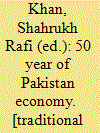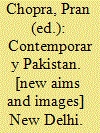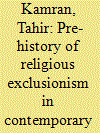| Srl | Item |
| 1 |
ID:
052560


|
|
|
|
|
| Publication |
New York, Oxford University Press, 1999.
|
| Description |
vi, 499p.
|
| Standard Number |
019577826X
|
|
|
|
|
|
|
|
|
|
|
|
Copies: C:1/I:0,R:0,Q:0
Circulation
| Accession# | Call# | Current Location | Status | Policy | Location |
| 043906 | 330.95491/KHA 043906 | Main | On Shelf | General | |
|
|
|
|
| 2 |
ID:
059681


|
|
|
|
|
| Publication |
New Delhi, Vikas Publishing House Pvt Ltd, 1983.
|
| Description |
vii, 184p.hbk
|
| Standard Number |
070692052X
|
|
|
|
|
|
|
|
|
|
|
|
Copies: C:1/I:0,R:0,Q:0
Circulation
| Accession# | Call# | Current Location | Status | Policy | Location |
| 022791 | 954.9105/CHO 022791 | Main | On Shelf | General | |
|
|
|
|
| 3 |
ID:
142712


|
|
|
|
|
| Summary/Abstract |
During the late nineteenth-century colonial era in India, the Khatam-e-Nubuwwat (Finality of the Prophethood) assumed remarkable salience as a theme for religious debate among Muslim sects. The controversies around the establishment of the Ahmadiya sect in 1889 brought the issue of Khatam-e-Nubuwwat to the centre stage of religious polemic or munazara. Tense relations continued between Ahmadiya and Sunnis, in particular, though the tension remained confined to the domain of religious polemic. However, immediately after Pakistan's creation, the Khatam-e-Nubuwwat squeezed itself out of the epistemic confines of the ‘theological’ and entered the realm of the ‘political’. Majlis-Tahafuz-i-Khatam-e-Nubuwwat (the Association for the Safety of the Finality of the Prophethood) grew out of the almost-defunct Majlis-i-Ahrar-i-Islam on 13 January 1949, with the principal objective of excluding the Ahmadiya sect from the Islamic fold.1 This article seeks to reveal how the Khatam-e-Nubuwwat has impinged upon the course of Pakistani politics from 1949 onwards as an instrument of religious exclusion, peaking in 1953. The pre-history of religious exclusion, which had 1889 as a watershed—the year when the Ahmadiya sect took a definitive shape—thus forms the initial part of the article.
|
|
|
|
|
|
|
|
|
|
|
|
|
|
|
|